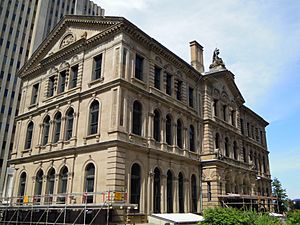Mary's Point facts for kids
Quick facts for kids Mary's Point |
|
|---|---|
 |
|
| Area | 12 square kilometres (4.6 sq mi) |
| Designated: | 24 May 1982 |
| Reference #: | 236 |
Mary's Point is a special natural area in New Brunswick, Canada. It's a large wetland, about 12 square kilometres (4.6 sq mi) in size. You can find it at the top of the famous Bay of Fundy, near a small town called Harvey. It's about 40 km (25 mi) south of Moncton.
Mary's Point is so important that it was named a 'Ramsar wetland of international importance' way back in 1982. It's also part of the Fundy Biosphere Reserve, which started in 2007. This reserve also includes the Shepody Bay wetland. Mary's Point was also the first Canadian site to join the Western Hemisphere Shorebird Reserve. This shows how vital it is for birds. The Canadian Wildlife Service helps manage this area.
Mary's Point is a crucial stop for shorebirds that fly south for the winter. These birds migrate from the Canadian subarctic all the way to South America! Up to two million semipalmated sandpipers visit each year. That's almost 75% of all these birds in the world! Millions of other bird species also stop here.
Most of the mudflats, about 940 ha (2,300 acres), are managed by the province of New Brunswick. The Canadian government owns another 107 ha (260 acres). This includes the most important spots where large groups of shorebirds rest during high tide. The rest of the land, mostly salt marsh, is privately owned.
Geography of Mary's Point
Mary's Point is an open piece of land that sticks out into Shepody Bay. Its height above sea level ranges from 2 m (6.6 ft) below to 10 m (33 ft) above. The area has huge mudflats that are covered and uncovered by the tides. There are also gravel beaches next to the land and shallow ocean areas.
In 1979, an organization called Ducks Unlimited Canada created a 20 ha (49 acres) pond near the salt marsh. This pond helps attract waterfowl.
Amazing Animals and Bird Migration
This area has the highest number of tiny creatures called Corophium volutator anywhere in the world. There can be up to 60,000 of them in just one square meter! These tiny animals are super important because they are food for the many migratory shorebirds.
During August, up to two million semipalmated sandpipers might use Mary's Point as a resting and feeding spot. As many as 200,000 of them can be there at any one time during their migration. These birds eat so much that they double their weight to about 40 g (1.4 oz). This gives them enough energy to fly across the Atlantic Ocean to the northern coast of South America. This amazing journey takes them two to four days!
Thousands of other bird species also stop at Mary's Point. These include the black-bellied plover, least sandpiper, white-rumped sandpiper, short-billed dowitcher, semipalmated plover, red knot, sanderling, and dunlin.
Also, smaller groups of American black duck, ring-necked duck, and blue-winged teal make their nests and raise their young at the pond created by Ducks Unlimited.
History of Mary's Point Quarry
Mary's Point was once a place where people dug for sandstone. In the 1800s, this quarry produced brownish-grey and brownish-red stone. This stone was called "Mary's Point Grey" and "Mary's Point Red." It was used to build structures all over eastern North America, even as far away as Philadelphia and New York City. For example, the Bethesda Terrace in Central Park uses Mary's Point stone.
The Mary's Point quarry produced about 4,000 tons of stone every year. It was popular because it was strong and easy to work with. The stone here is part of the same rock formation as Grindstone Island, which is nearby in Shepody Bay.
George Lang, a famous builder, worked with the quarry (which was once called the Albert Freestone Company). He used Mary's Point stone for several important buildings in Halifax. The quarry was last opened in 1987. This was to provide stone for fixing up the old Dominion Building in Halifax, which is now the Art Gallery of Nova Scotia. Other buildings in Halifax that used Mary's Point stone include the Welsford-Parker Monument (built in 1857), the Halifax Court House (built 1858-1863), and The Halifax Club (built in 1862).


